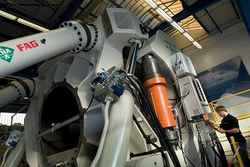
Posted to News on 6th Mar 2012, 14:25
Bearing test rig for wind power applications now operational
Schaeffler has commissioned a new test rig that will help to reduce wind turbine development times.

After less than two years, The Schaeffler Group has completed the design and build of Astraios, which it describes as the world's largest, most powerful test rig for large size bearings. The test rig is now fully operational and was officially opened at Schaeffler's Schweinfurt plant in Germany in November. Named after the Titan from Greek mythology who fathered the four wind gods, the Astraios test rig enables large bearings weighing up to 15tonnes with outside diameters up to 3.5m, particularly those used in wind power applications, to be fully tested in realistic conditions using a comprehensive simulation programme.
At a cost of around EUR7million, Astraios is a significant investment but it enables Schaeffler to help reduce wind turbine development times for customers, as well as improving the reliability, safety and cost-effectiveness of future wind turbine designs.
Astraios will be primarily used to test rotor bearings for multi-megawatt wind turbines, and will help to further improve the understanding of wind turbine systems, the influencing factors and the interrelationship between drive train components. The tests will also provide useful insights into wind turbine operation and maintenance, as well as information on how to optimise the design of adjacent constructions.
Renewable energy
In her speech at the opening of Astraios, Maria-Elisabeth Schaeffler, partner in The Schaeffler Group, commented: "For Schaeffler, this large size bearing test stand is a logical step towards further developing renewable energy as a strategic growth sector."
According to Dr Juergen M Geissinger, the CEO of Schaeffler, the company is well prepared to face the global challenges presented by renewable energies thanks to its products and technologies, as well as its position in growing market sectors. "In addition to wind power, solar, wave and tidal power are becoming increasingly important. Our solutions play a very significant part in making these new technologies reliable and cost effective."
Set up and function of Astraios
Astraios will perform realistic simulations of static and dynamic loads that act on the rotor bearings and slewing rings. All rotor bearing concepts for wind turbines with an output of up to 6MW can be tested. Functional tests will provide insights into rolling bearing kinematics, temperature and friction behaviour, loads and deformation. The data required for these tests will be provided by more than 300 different sensors mounted on the test rig and in the bearings.
The loading frame is the most important part of the test rig. Four radial and four axial hydraulic cylinders are fixed to this frame to generate the real loads and moment forces that occur in a wind turbine. The radial cylinders simulate the weight of a rotor hub with rotor blades, while the axial cylinders generate the wind loads.
On a large wind turbine, the rotors and hub can weigh in excess of 100tonnes. This weight acts on the bearing and generates a static radial load and a static 'nodding' moment. Accordingly, the four radial cylinders have very large dimensions, as each cylinder can generate a maximum of one meganewton of force, which is equivalent to 100tonnes of weight. The axial cylinders provide even more - up to 1.5meganewton for simulating static axial loads as well as the dynamic nodding and yawing moments. This nodding and yawing is comparable with the lifting, lowering and turning of the wind turbine nacelle.
Different wind speeds are simulated using the test rig's drive train and planetary gearbox. Typical speeds are 4-20rpm, although it is also possible to simulate significantly higher speeds.
The tensioning frame acts as the connection side of the wind turbine's nacelle. Wind seldom blows at the same speed or from the same direction, but acts with varying intensity and at different points on the wind turbine. Varying moments are generated on the rotor hub, depending on the position of the rotating rotor blades. If the wind acts on the top or bottom of the rotor blades, for example, it generates a dynamic nodding moment. This is supplemented by a dynamic yawing moment if the wind turns and blows more strongly from the side.
Together, these factors mean that wind turbines are subjected to extremely complex conditions due to the continuously changing wind conditions. This is a Herculean task, not only for the test stand and the eight hydraulic cylinders that simulate all loads and moments, but also for SARA (Schaeffler's Automation System for Research & Development Applications), which automatically controls the comprehensive test and measurement programme, as well as all open- and closed-loop control processes on the test rig. As well as generating target values according to the wind load, SARA also controls all test rig units, including the highly dynamic servo cylinders. SARA does the following: it ensures that all data is measured and recorded; it is responsible for bearing measurement telemetry systems; it displays all target, actual and limit values; it provides data logging; and it evaluates all measurement data.
For more information about the Astraios test rig and how it can support wind turbine development, call the Marketing Department on +44 (0)121 313 5870 or email [email protected].
Want the latest machine building news straight to your inbox? Become a MachineBuilding member for free today >>

















